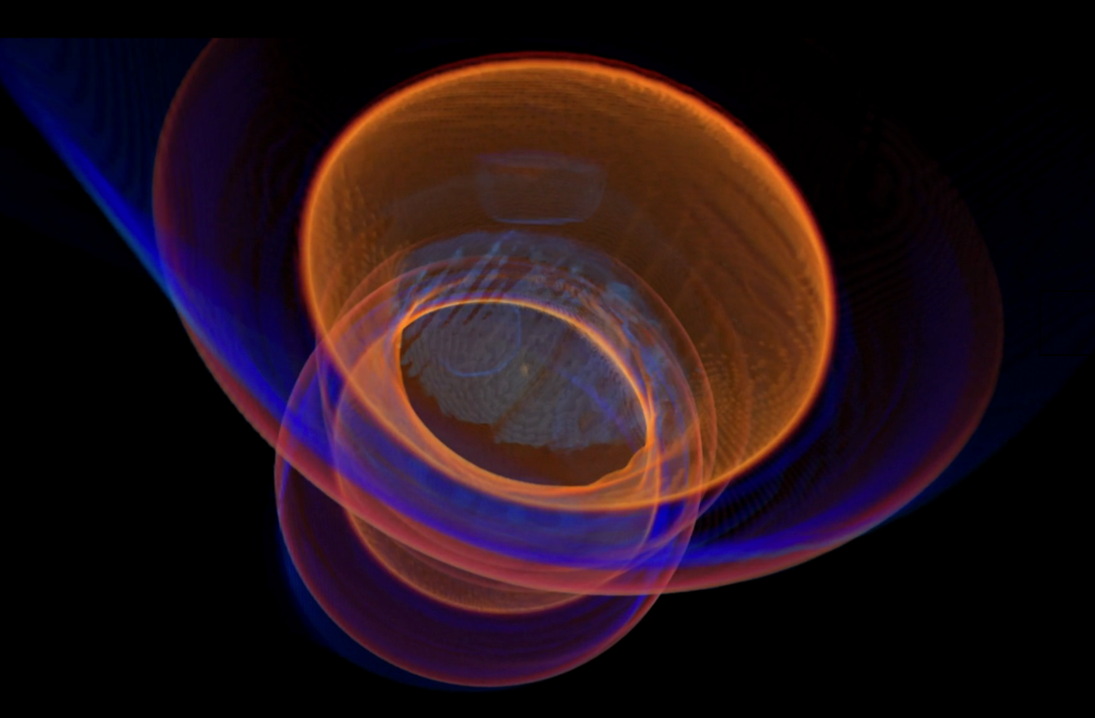Dissecting a Supernova: A Star Explosion Post-mortem (Videos)

Astronomers have spotted a new object emerging from the ashes of a recently deceased star. The stellar post-mortem, which is recounted in two new videos, may also solve a mystery surrounding the unexpected shape of the star's explosive remains, scientists say.
In February 1987, astronomers saw a new point of light appear in the sky: a supernova explosion, roughly 150,000 light-years from Earth. A massive star had reached the end of its fuel supply and gone down in a blaze of glory. Since then, scientists have studied the corpse of Supernova 1987A extensively, including visualizing the supernova's dissection in a new video.
"It's like doing a forensic investigation into the death of a star," said Giovanna Zanardo, a Ph.D. candidate at the University of Western Australia, in a statement. [Supernova Photos: Great Images of Star Explosions]
Zanardo and a group of collaborators from the International Centre for Radio Astronomy Research (ICRAR) in Perth, Western Australia, have highlighted some of their most recent findings about 1987A in two videos. In them, the researchers "dissect" the supernova remains with observations, and attempt to recreate the event using computer models.
The ICRAR scientists believe they have identified a pulsar or neutron star in the supernova debris. When massive stars die, the leftover material may collapse down into an incredibly dense object called a neutron star. Pulsars are rapidly spinning neutron stars that radiate bright beams of light that appear to pulse on and off, like a lighthouse.
Images featured in one supernova video show what the ICRAR scientists say is light from the new object.
The challenge in identifying this object, said the researchers, is detecting its faint light in the bright chaos of the debris field. In order to disentangle the different light sources, the researchers combined observations from two telescopes: the Atacama Large Millimetre/submillimeter Array (ALMA) in Chile's Atacama Desert and the Australia Telescope Compact Array (ATCA) in New South Wales.
Get the Space.com Newsletter
Breaking space news, the latest updates on rocket launches, skywatching events and more!
The combined observations allowed the ICRAR researchers to see different wavelengths of light emitted by the stellar remains: waves, microwaves and infrared light. Analyzing each of these wavelengths alone enabled the researchers to look for different objects that radiate different kinds of light.
In the second supernova video, the ICRAR scientists show how they may have also solved a long-standing mystery about the shock wave that is still expanding away from the supernova remnant.
Scientists have observed that one side of the supernova explosion appears brighter than the other. To figure out why, researchers at ICRAR developed a 3D simulation of the stellar death. They found that tweaking things in the simulation, like the asymmetry of the explosion and the composition of the gas surrounding the supernova, changed the outcome and eventually created models that agree with the new observations.
"The fact that the model matches the observations so well means that we now have a good handle on the physics of the expanding remnant, and are beginning to understand the composition of the environment surrounding the supernova," said Toby Potter, a UWA researcher at ICRAR, said in the statement. This understanding, he said, "is a big piece of the puzzle solved in terms of how the remnant of SN1987A formed."
Follow Calla Cofield @callacofield. Follow us @Spacedotcom, Facebook and Google+. Original article on Space.com.
Join our Space Forums to keep talking space on the latest missions, night sky and more! And if you have a news tip, correction or comment, let us know at: community@space.com.

Calla Cofield joined Space.com's crew in October 2014. She enjoys writing about black holes, exploding stars, ripples in space-time, science in comic books, and all the mysteries of the cosmos. Prior to joining Space.com Calla worked as a freelance writer, with her work appearing in APS News, Symmetry magazine, Scientific American, Nature News, Physics World, and others. From 2010 to 2014 she was a producer for The Physics Central Podcast. Previously, Calla worked at the American Museum of Natural History in New York City (hands down the best office building ever) and SLAC National Accelerator Laboratory in California. Calla studied physics at the University of Massachusetts, Amherst and is originally from Sandy, Utah. In 2018, Calla left Space.com to join NASA's Jet Propulsion Laboratory media team where she oversees astronomy, physics, exoplanets and the Cold Atom Lab mission. She has been underground at three of the largest particle accelerators in the world and would really like to know what the heck dark matter is. Contact Calla via: E-Mail – Twitter









